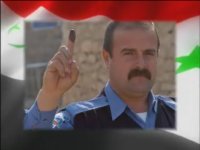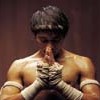WELCOME TO TAPAKTUAN, AND THE WAY TO CALANG
 |
| Tapaktuan, Kota Naga |
arrived on the afternoon of January 8, having left Medan the previous evening at 11pm. By pure coincidence (or not?),
Bang (elder brother) Azly and
Ibu (Mother) had flown from Jakarta into Medan just a few hours before me -- she had been in the capital since Azly had brought her and
Ayah (Father) there a few weeks after the tsunami. Ayah had been ill at that time, was hospitalised in Medan, and sadly passed away soon after reaching Jakarta. The fact that we had independently booked flights on the same day was considered by everyone to be evidence of our "
kontak batin," or inner contact. A family friend had driven the 10-12 hours from Tapaktuan to meet them in Medan, and so I travelled with them for Ibu's long awaited homecoming.
Some readers will know the story of my friend Uddin, the youngest of the brothers. We had known each other since 1990, and I made four trips back there until the last time I saw him in April 1998. By the following year, the conflict in Aceh had become hot -- the population was demonstrating in support of a referendum on Aceh's status, and the separatist movement GAM was launching attacks on both security forces and civilians. Following a massive show of support for a referendum in the capital Banda Aceh, and upon returning to Tapaktuan around October 16, 1999, Uddin was kidnapped and murdered. It is believed that demands had previously been made on him to join GAM, and he had refused. People in this area of South Aceh had been afraid to take any side during this period, for fear of repercussions either from GAM or the TNI, the Indonesian military. They preferred to stay out of either camp, and to support a peaceful and political path for a solution to the long running question of independence, autonomy or integration. The mass rally in Banda Aceh had been completely peaceful, and was estimated to have had around a million participants (the population of Aceh at the time was just over 4 million).
I believe that was the last full day of Uddin's life. He was taken to a GAM stronghold in nearby Kota Fajar, and killed in a most horrible manner. It would be another year and a half before I was able to return in April 2001, when I would first hear this story from Ibu's lips. Uddin's third son had been born just two months before he was taken.
When we arrived at Bang Hamdani's house, Uddin's widow and her three young sons were waiting along with other family and friends, and many tears of joy were in evidence at the first sight of Ibu in almost a year. Here we see Ibu on the right, with Ana, Uddin's widow beside her and his middle son, Agung, at her knee. Bang Hamdani, one of Uddin's older brothers is in black seated on a chair, his wife Ade in the US Army shirt, and Uddin's oldest son Angga seated between them. Dani's son Krisna is in the other chair, and Mudir (in the blue shirt apparently doing SMS) is one of our many companions during excursions with Uddin in years past.
A few days after our arrival, another of our oldest friends (and Uddin's best pal) Azirwan came by in the evening to ask if I'd like to accompany him on a trip to Meulaboh and Calang ("
Cha-lung"). He'd been hired to drive some people there, and I was welcome to join. Of course I would be ready at the crack of 7am! We would leave early and return the same evening -- or that was the plan. Normally it is about 3 1/2 hours to Meulaboh, and another hour and a half to Calang. Tapaktuan had been barely touched by the tsunami, and although I had already passed through one area which had been damaged -- at Bakongan, several hours south of here -- I was looking for an opportunity like this to see how the most badly hit areas further north were faring after a year.
The other passengers in Azirwan's Kijang were late that morning ("
jam karet," everyone laughs -- "rubber time"), but it wouldn't have mattered had we left home at 4am. Beyond Meulaboh, the road was unbelievable, and for hours our top speed wouldn't exceed 10 kph (we were not to even reach Calang that night, and would stay in a refugee camp instead). This is a shot of the coastline just north of Tapaktuan, in the Sawang area. Most of these photos were taken on the fly, out the window of the Kijang -- so forgive me if they're often not quite level. Here we're still about an hour's drive before reaching Labuan Haji, the nearest place to Tapaktuan that suffered damage and loss of life to the tsunami. Note the steep terrain reaching right up to the coastline -- the water depth drops off sharply as well, and this what I believe contributed to the relatively light effects of the tsunami waves in these areas.
 |
|
After stopping in Blangpidie to pick up more passengers around noon, we reached the devastation around Meulaboh in mid-afternoon. Vast stretches of inland lagoons have been created in these flat lands, where the only things standing, for several kilometers from the beach, were dead trees (killed by the seawater). This picture is much closer to the beach, where the
kelapa trees are more tolerant of saltwater. Before the tsunami, this would have been the view of a thriving hamlet -- including the present lagoon itself. Some foundation remnants are visible, the beach is just beyond the distant fringe of coconut palms.
Our little expedition -- who but for Azir and I, were all women and children -- stopped at around 3pm at a small mesjid, just beyond Meulaboh to have lunch. The men we talked to there told us we could drink the water in the
mandi (in this case, a small outbuilding next to the mesjid for bathing and toilet facility). The mandi is a water reservoir inside the building. In Indonesia, you
never drink any sort of tapwater without first boiling it. Here we were in the tsunami devastation zone, and there was clean tapwater to drink! Foreign aid -- as I recall in this case, it was Swedish -- had bored many water wells in these hamlets around Samatiga, to a depth of around 100 meters. The men told us that 13 such hamlets, or
desas, had been completely wiped out by the tsunami waves. They pointed out a school next to the mesjid, which had been constructed by the French military.
As we continue northwards away from Meulaboh the road takes to the beachside as it circumvents many destroyed bridges, and we are driving on hardpacked black sand. Seemingly endless miles of scenes like this, which once were thriving communities. For the most part, one sees only the tightly clustered foundations, bare floors with the occasional bit of ceramic work standing above them -- what's left of the house's own mandi. Most of these foundations were marked with a small sign pushed into the ground, denoting the owner's name. This building was much more substantial than most in this desa, perhaps a commercial shophouse. The entire field of view would have been filled with small houses.
 |
|
 |
|
Continuing north along this stretch of coast, it's apparent just how much land the sea has claimed back. In addition to the beach itself being moved hundreds of yards further inland, as you can see by the dead kelapas way out in the bay, an endless series of inland lagoons have formed behind the new beachline. In the right-hand photo, although they aren't visible here, there were house foundations all around us. I remember these desas near the beach from my first trip to Aceh in 1990, when I took public buses from Banda Aceh in the far north, and passed through these little hamlets heading south. They remain vivid in my mind, so peacefully nestled amid the tall coconut palms, red tiled roofs, tended gardens and orchards.
 |
|
These are some of the new permanent housing being built, just a very short distance from those two photos above. Many, many people are still living in tents, or in very flimsy temporary housing until they can receive a good, durable house like these. Among the most prominent aid groups involved in constructing these settlements, are the Islamic Relief, the Mercy Corps, and the CRS (I believe that's Catholic Relief Services). There's usually a sign, flag or banner next to the rebuilding projects for housing or bridge construction, stating that the project is being done with the cooperation of one of these groups. Most of the labour is done by the local population, in what was touted on one billboard as a "cash for work program." What an innovation -- cash for work! Emergency shelters and tents often were emblazoned with UNICEF and UNHCR in massive lettering. Governmental projects were also seen, including Singapore, Japan, Norway and USAID and others. But to my eyes, the building seems to be proceeding very slowly, and most of the permanent structures were only half-built or less.
 |
|
Soon after passing that housing project, the old road simply disintegrated, and the new road took a turn inland. It was newly cut right through a dense forest, and the trees were so tall on both sides that it was too dark to get pictures of the second worst road I've ever seen in my life (the worst was in northern Honduras following a hurricane -- don't ask). Some areas had been cleared for resettlements, where signs announced that "Desa Such-and-such will be moved here." These are still choked with logs and logging debris, it will be a long time before they're ready to be settled by anyone. The road itself was a matter of driving into one giant water-filled hole -- about 5 meters from shore to shore, and several feet deep -- then through it, out the other side, and immediately into the next one. The ground itself was fairly hard, but one never knew what lay under the water. It went on that way for several hours, and we proceeded at a snail's pace -- but without incident. When we finally emerged from the dark forest, and could once again see the flatlands to the coast, we were rewarded by this spectacular sunset.
 |
|
This is somewhere around Teunom, and we would drive another hour and a half over dry, but extremely washboard road, before reaching a tsunami refugee encampment a few miles beyond Kreung Sabee, at a place called Desa Mon Mata. We were only 8-10 km from Calang, and would drive there the next morning. This last stretch of the way can be seen on
this map (at the bottom) from Teunom to Calang. To be continued.
[Read Part II of this journey
here]























 Our way of saying "thanks" in the Thai way. Here a nak muay Thai (kickboxer) offers respect and thanks for his teacher (wai khru) before a match. This is our local variation on the ubiquitous "hat tip" used in general blog culture.
Our way of saying "thanks" in the Thai way. Here a nak muay Thai (kickboxer) offers respect and thanks for his teacher (wai khru) before a match. This is our local variation on the ubiquitous "hat tip" used in general blog culture.





